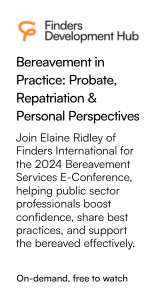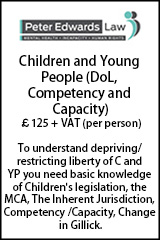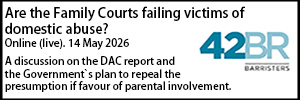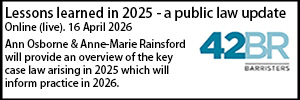The “whodunit?” problem in care proceedings revisited in 2024
- Details
Is the warning against straining to identify the perpetrator of injuries dead and buried? Anthony Hand looks at recent developments.
The “whodunit?” problem in care proceedings…..It is a particularly thorny problem for Local Authorities to consider in the first instance, and ultimately for the courts to decide upon.
Sadly, sometimes babies are injured in the care of their parents (or relatives or other cares). Some such injuries may fall into the category of non-accidental injuries. This is where a parent is at fault for the injuries by their acts or omissions. But getting to the truth of what happened to the child is always a difficulty. It may be clear that a child suffered fractures, but were they caused by the mother, or maybe the father, or could it have all have happened whilst the child was at nursery? The conundrums posed by such cases occupy the majority of my working life. That is the area I practice in.
In 2009, I was counsel for the Local Authority in the Court of Appeal in a case known as Re D (2009) 2 FLR 2009. In that case the court had to grapple with the problem of which parent had injured the baby. Was it more likely the mother? Or was it probably the father? Here Wall LJ said sometimes parents do not always tell the truth, and the court in appropriate circumstances should not “strain” to identify if it specifically was the mother, or it was specifically the father, who caused the injuries. Rather, the court should make a “pool” finding that both parents were in the pool of possible perpetrators regarding the injuries.
Later that same year, Wall LJ’s judgment in Re D received approval from the Supreme Court in Re S-B (children) (2009) UKSC 17. Lady Hale in the Supreme Court: “Of course, it may be difficult for the judge to decide, even on the balance of probabilities, who has caused the harm to the child. There is no obligation to do so. As we have already seen, unlike a finding of harm, it is not a necessary ingredient of the threshold criteria. As Lord Justice Wall put it in Re D (Care Proceedings: Preliminary Hearings) [2009] EWCA Civ 472, [2009] 2 FLR 668, at para 12, judges should not strain to identify the perpetrator as a result of the decision in Re B: “If an individual perpetrator can be properly identified on the balance of probabilities, then . . . it is the judge’s duty to identify him or her. But the judge should not start from the premise that it will only be in an exceptional case that it will not be possible to make such an identification””
Wind forward 13 years. The Court of Appeal in Re A (children) (pool of perpetrators) (2022) EWCA Civ 1248, again considered the appropriate test to be applied in these family whodunit cases. In Re A, King LJ acknowledged the approval given by the Supreme Court in 2009 to the Re D test.
However, what the 2022 judgment in Re A concludes is that, to paraphrase, the thinking of the Supreme Court in other areas is now to deprecate the use of glosses on legal principles. King LJ concludes:
“The evaluation of the facts which will enable a court to identify the perpetrator of an inflicted injury to a child will be determined on the simple balance of probabilities and nothing more…I am of the view that to go further and to add that the courts should not "strain" to make such a finding is an unnecessary and potentially unhelpful gloss which has outlived its usefulness…
I suggest, therefore, that in future cases judges should no longer direct themselves on the necessity of avoiding "straining to identify a perpetrator". The unvarnished test is clear: following a consideration of all the available evidence and applying the simple balance of probabilities, a judge either can, or cannot, identify a perpetrator. If he or she cannot do so, then, in accordance with Re B (2019), he or she should consider whether there is a real possibility that each individual on the list inflicted the injury in question.”
Clarification from the Court of Appeal is always welcome, but the point that ran through my mind after Re A is that arguably we now have the Court of Appeal in Re A indicating that the maxim positively endorsed by the Supreme Court 13 years earlier is no longer unhelpful and should no longer be used.
King LJ may well be correct, but I felt (and still feel) a tension between the 2022 Court of Appeal judgment, and the earlier Supreme Court judgment which on the rules of precedence should rank above it. My feeling was that this point needed to be clarified, and I awaited the appropriate case to come forward and do that job….
Move on a couple of years until the later summer of 2024. Y, V & B (Fact-Finding: Perpetrator) [2024] EWCA Civ 1034 came before the Court of Appeal. It was a fact finding where the court was trying to work out who caused injuries to the child. As is often the case, there were a number of adults who could have caused the injuries. I have included the case because Baker LJ neatly sets out in one place all the law applicable on identifying the perpetrator of injuries. Importantly, Baker LJ set out the following in the 2024 case:
“At one point, it was suggested that a court in care proceedings should "not strain to identify a perpetrator". That suggestion has now been disavowed: Re A (Children) (Pool of Perpetrators) [2022] EWCA Civ 1348. Thus the straightforward position is as summarised by King LJ in that case at paragraph 34:
"The unvarnished test is clear: following a consideration of all the available evidence and applying the simple balance of probabilities, a judge either can, or cannot, identify a perpetrator. If he or she cannot do so, then, in accordance with Re B [2019], he or she should consider whether there is a real possibility that each individual on the list inflicted the injury in question."”
I.e. Baker LJ agrees with King LJ’s decision that came a couple of years earlier.
So, for me that realistically brings to an end the line of thought that suggests in cases where harm to a child has been found that the court should not “strain” to identify whether it was the mother or father (or grandparent, aunt, or childminder etc) who caused the injuries. Rather, the starting point is that the court must simply ask on a balance of probabilities which adult was most likely to have caused the injuries? If the court can answer that question positively on a balance of probabilities, a specific perpetrator finding is made. If the court cannot decide who was the most likely perpetrator, the court goes onto consider whether it should make a pool finding that the injuries could have been caused by X, Y or Z. But in that process “straining”, or probably more accurately the warning not to “strain” is now nowhere to be seen.
Perhaps there is scope on the right case to try and argue that the Court of Appeal in the 2022 Re A case (King LJ), and the 2024 Re A case (Baker LJ), have got it wrong and to argue this is a suitable point to be considered by the Supreme Court. However, my feeling is that this would be a long shot, and finding the appropriate case where it factually made a difference may be hard (but not impossible).
I guess never say “never”, but for now the two Re A Court of Appeal judgments rule the roost in this area.
PS – The Baker LJ judgment from 2024 also highlights the following passage by Peter Jackson LJ in Re B (Children; Uncertain Perpetrator) [2019] EWCA Civ 575. I include it as I think it’s a useful one for Local Authorities to ponder at the outset of care proceedings relating to injuries.
“52. Lastly, as part of the court's normal case-management responsibilities it should at the outset of proceedings of this kind ensure (i) that a list of possible perpetrators is created, and (ii) that directions are given for the local authority to gather (either itself or through other agencies) all relevant information about and from those individuals, and (iii) that those against whom allegations are made are given the opportunity to be heard. By these means some of the complications that can arise in these difficult cases may be avoided." Peter Jackson LJ
Anthony Hand is Head of Chambers at College Chambers, Southampton.












































